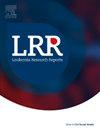Treatment outcomes and survival analysis of pediatric mature B-Cell non-Hodgkin lymphoma: A retrospective study comparing LMB96 and R-CHOP regimens
IF 0.9
Q4 HEMATOLOGY
引用次数: 0
Abstract
Background
Mature B-cell non-Hodgkin lymphoma (B-NHL) is a prevalent pediatric malignancy with significant treatment advancements. This study retrospectively analyzes clinical characteristics, treatment outcomes, and survival rates of children and adolescents diagnosed with B-NHL at Al-Hasan Al-Mojtaba Hospital between January 2014 and December 2024. A comparative analysis was performed between the LMB96 and R-CHOP regimens.
Methods
Patients with confirmed diagnoses of Large B-cell lymphoma or Burkitt’s lymphoma, based on WHO classification criteria, were included. Staging was conducted using the St. Jude system, and risk classification followed the FAB/LMB criteria. Treatment involved a modified LMB96 regimen, later replaced by R-CHOP in the last two years of the study. Event-free survival (EFS) was analyzed using Kaplan-Meier survival curves, with stratifications by staging, risk group, and gender.
Results
A total of 66 patients were included (median age: 5.8 years; 69.7 % male). Burkitt’s lymphoma was the predominant histology (86.3 %). The abdomen was the most common primary site (84.8 %). The majority of patients (72.7 %) presented with advanced-stage disease (Stages III and IV). Risk group classification identified 62.1 % of patients in Group B and 28.8 % in Group C. Kaplan-Meier survival analysis revealed Group A had the most favorable prognosis (EFS ∼100 %), followed by Group B (∼75 %), and Group C (∼50 %). Disease stage significantly influenced survival (p = 0.021), with Stage IV patients demonstrating the poorest outcomes. While female patients exhibited higher EFS than males, the difference was not statistically significant (p = 0.27). By the end of follow-up, 28.8 % of patients had experienced a fatal outcome.
Conclusion
Advanced-stage B-NHL remains prevalent, with significant survival differences based on staging and risk classification. The transition from LMB96 to R-CHOP warrants further evaluation to optimize pediatric treatment strategies. Larger studies are needed to validate observed gender-based survival trends.
儿童成熟b细胞非霍奇金淋巴瘤的治疗结果和生存分析:一项比较LMB96和R-CHOP方案的回顾性研究
成熟b细胞非霍奇金淋巴瘤(B-NHL)是一种常见的儿科恶性肿瘤,治疗进展显著。本研究回顾性分析了2014年1月至2024年12月在Al-Hasan Al-Mojtaba医院诊断为B-NHL的儿童和青少年的临床特征、治疗结果和生存率。对LMB96和R-CHOP方案进行了比较分析。方法根据WHO的分类标准,纳入确诊为大b细胞淋巴瘤或伯基特淋巴瘤的患者。采用St. Jude系统进行分期,并按照FAB/LMB标准进行风险分类。治疗包括改良的LMB96方案,后来在研究的最后两年被R-CHOP取代。使用Kaplan-Meier生存曲线分析无事件生存(EFS),并按分期、风险组和性别进行分层。结果共纳入66例患者(中位年龄:5.8岁;69.7%男性)。Burkitt淋巴瘤为主要组织学类型(86.3%)。腹部是最常见的原发部位(84.8%)。大多数患者(72.7%)表现为晚期疾病(III期和IV期)。风险组分类确定了B组62.1%的患者和C组28.8%的患者。Kaplan-Meier生存分析显示,A组预后最佳(EFS ~ 100%),其次是B组(~ 75%)和C组(~ 50%)。疾病分期显著影响生存率(p = 0.021),其中IV期患者预后最差。女性患者的EFS高于男性,但差异无统计学意义(p = 0.27)。到随访结束时,28.8%的患者经历了致命的结果。结论晚期B-NHL仍然普遍存在,根据分期和风险分类存在显著的生存差异。从LMB96到R-CHOP的过渡值得进一步评估,以优化儿科治疗策略。需要更大规模的研究来验证观察到的基于性别的生存趋势。
本文章由计算机程序翻译,如有差异,请以英文原文为准。
求助全文
约1分钟内获得全文
求助全文

 求助内容:
求助内容: 应助结果提醒方式:
应助结果提醒方式:


